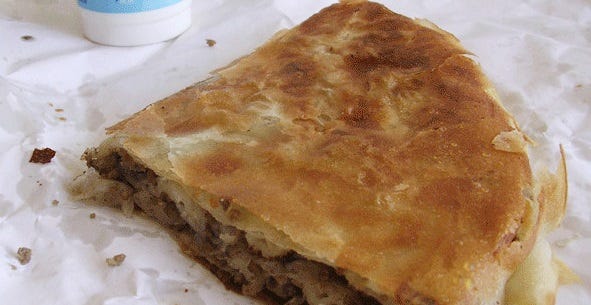Seven Surprising Things About Belgrade (and Serbia)
This Balkan nation has a long history of warfare. When visiting, that's difficult to forget.
Belgrade, Serbia, is a city with a long and storied history of military conflict: before, during, and after it was the former capital of the since-dissolved country of Yugoslavia.
And to this day, Serbians take a fair amount of pride in that history.
It’s possible they take too much pride in that history, in the way that Star Trek’s Klingons also take too much pride in their history of warfare.
But more on that in a bit. In the meantime, here are seven things about Belgrade — and Serbia in general — that surprised us, not all of them are good.
(1) Skadarlija Street is charming.
Before visiting Belgrade, we’d been warned not to expect much in the way of typical European charm, that the city was a bit gritty.
And it kinda is.
But it also includes the neighborhood known as Skadarlija, which has plenty of charm.
Known as Belgrade’s Bohemian Quarter, the Skadarlija neighborhood dates back to 1830, when “Gypsies” — properly known as Roma — first settled there. Later in the 19th century, it became home to artists, writers, and other creative types, hence the “Bohemian” vibe.
The heart of Skadarlija is Skadarska Street — and it’s the place to go when you’re looking for a good meal. Charming restaurants and bistros line the sloping street as it winds down to a bustling Farmer’s Market.
Skadarska Street doesn’t allow cars — except for the occasional restaurant prop, see below — which means the pace is slower. The whole point is to meander. Definitely check out one of the kafanas, or Serbian bars, where waiters often wear traditional Serbian clothing, and musicians offer up traditional music.
If you don’t mind being off the street itself, try Casa Nova, a wonderful Italian restaurant. Brent recommends the gnocchi!
(2) Belgrade’s location might be a little too strategic.
Belgrade sits at the spot where the River Sava flows into the Danube.
Which has traditionally been a very strategic location. The area directly overlooking the confluence has been fortified since the 3rd century BC, and the fortifications are now known as Belgrade Fortress, right in the heart of sprawling Kalemegdan Park.

Belgrade also lies in the middle of the most direct route from Turkey to Western Europe — which matters because these two areas have been attacking each other for millennia.
The two sides often fought for control of Belgrade, with the losing side retreating to the opposite side of the Danube. That meant the river was frequently a border between warring factions. Even today, you’re more likely to see Ottoman architecture on the Belgrade side of the river, and Austrian on the other.
But honestly, there aren’t very many older buildings at all, because of all of the fighting over the years: at least 115 different wars that have razed the city an astonishing 44 times.
The first recorded battle for control of what is today Belgrade took place in 279 BC, when the Galls swept in and booted out the Thracians. Over the centuries the area has been conquered or attacked by — and this is only a partial list! — the Romans, the Ostrogoths, the Avars, the Huns (several times, including once by Attila), the Ottomans, the Habsburgs, both the Axis and the Allied powers during World War II, and finally by NATO forces in 1999, trying to stop Serbian aggression in Kosovo.
But it’s hard to feel too bad for the Serbs over that one, since they started the fighting.
I said before that the Serbs take great pride in their long military history, and it’s true. Take a look at this chandelier inside a church. The church’s fixtures are all made of, yes, old bullet casings:
I get wanting to take pride in your past. But a chandelier made of bullet casings inside a church? Seems wrong to me.
(3) Belgrade is very inexpensive (by Western standards).
Most of Eastern Europe is extremely affordable by Western standards, so this wasn’t exactly a “surprise” that Serbia is too.
But from our point of view, it was still nice.
A nice hotel room will generally run $30-$80 USD a night, and a more-than-decent Airbnb for a month will run around $1000 — more during the summer high season, but much less in winter. Breakfast is, at most, $5, and a fine meal out, with wine and maybe even dessert, won’t cost more than $15 per person.
Naturally, you can eat street food or take-away for much, much less. A filling slice of burek, which is a flakey pie filled cheese, meat, or spinach, is around $1.

Keep in mind that this is Eastern Europe, and the Serbs definitely love their meat. And when in Rome — er, Belgrade — Brent and I weren’t about to turn up our noses at it, especially the delicious sausage sandwiches.
We found our favorites at Kuća Kobasice, or Sausage House, in Novi Sad, about an hour from Belgrade, where the sandwiches sold for about $3. Our choice of sandwich was the Sremska, or Garlic Sausage, which includes more garlic than literally any food item we have both ever tasted.
We didn’t kiss for days afterward, but it was worth it.
Keep reading with a 7-day free trial
Subscribe to Brent and Michael Are Going Places to keep reading this post and get 7 days of free access to the full post archives.





